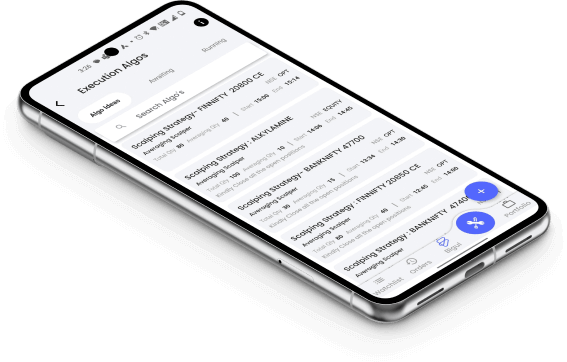Open an Account & Start Algo Trading Today!
- Flat Rs 18 brokerage
- No Cost Algo Trading
- Trade from Chart
- 30+ Indicators
- Stock SIP
- Smart Case
- Bigul Option Chain
- 300+ Pre Defined Market Watch
- IPOs
- Basket Order
Intraday Trading Tips for Beginners
For
beginners looking to make quick money, intraday trading is a very popular stock
market. This type of trading offers exciting opportunities because it is fast.
But in such a rapid environment there are also considerable risks.
Newcomers
may find themselves in tricky situations, and this could end up severely
hurting their investment value if they do not have proper strategies for this
purpose. This helps reduce these risks and maximize profitable trades.
The article will discuss key tips that every novice needs to learn to sail through the challenges of intraday trading successfully.
Understanding Intraday Trading
Intraday
trading is the practice of buying and selling financial instruments within the
same trading day. This implies that all positions are opened and closed
overnight, with no positions held overnight. Traders seek to benefit from
temporary changes in stock prices or exchange-traded funds (ETFs) or other
securities.
The traders
watch real-time charts closely and adopt various strategies such as scalping,
ranging trading, news-based trading to profit from them.
The aim here is to have many trades throughout the day that exploit small movements in prices resulting in returns.
Now, let’s discuss a few intraday trading tips for newbies.
Best Intraday Trading Tips for Beginners
In the Indian share market, below are a few of the intraday trading tips that will help investors to make the right choice:
1. Choose Liquid Stocks
It is important to choose liquid stocks when it comes
to intraday trading as this allows for quick
buying and selling of shares
without causing significant price changes. These stocks have high trading
volumes, resulting in sufficient market participation.
This high liquidity makes it easier to enter and exit
positions smoothly, thus reducing the risk of slippage where execution prices
deviate from the expected price.
Trading liquid stocks helps you profit from small price movements and implement strategies effectively, hence enhancing your trade outcomes.
2. Set Stop-Loss and Take-Profit Orders
It is important to note that placing stop-loss and
take-profit orders is essential for intraday trading risk management and profit
protection. A stop-loss order executes the sale of a stock automatically when
its price drops to a predetermined level, thereby limiting your possible loss.
For instance, if you buy a share at ₹100 per share and
set your stop-loss at ₹95, the stock will be sold once its price is down to ₹95
thereby limiting your loss on that particular stock by ₹5.
Conversely, take-profit order secures profits when
stocks are sold with ease after reaching some specific target price. For
example, if you place a take-profit order at ₹110, whenever the share hits ₹110
it will be sold consequently securing a per-share income of ₹10.
By using both orders, one can manage risks and ensure that they make profits without having emotional influence over them.
3. Avoid Overtrading
Overtrading has to be avoided as its results can bring
about significant blunders and additional costs in the form of transactions
when trading intraday.
Overtrading is often a reaction to emotions or an
attempt to recover losses; however, it clouds judgment and leads to poor
decision-making. Instead, you should concentrate on fewer but high-quality
trades that fit into your trade plan and strategy.
Being selective and disciplined with trades reduces the risk of losses and ensures that every trade has a clear purpose for entering into it. This way, you have some kind of clarity over your trading activities.
4. Follow a Trading Plan
A trader who does not follow a trading plan may fail
at intraday trading. A trading plan indicates how you will enter or exit
specific investments, rules for managing risk, identification criteria for
trades among other things that guide a systematic approach towards investment
decisions. It helps make your decisions objective rather than being influenced
by abrupt changes in market prices.
By staying within your plan, you achieve consistency in
your trading style, which prevents emotional mistakes while trading.
Additionally, having a well-defined plan enables you to measure performance, fine-tune strategies and stay focused as essential elements in managing risk towards successful intraday trading careers.
5. Use Technical Analysis
Technical analysis makes use of charts and indicators
to analyze the price movements of stocks and make transactional decisions.
The key tools are moving averages, which get rid of
noise in price data revealing trends, and the Relative Strength Index (RSI),
which determines when prices may be too high relative to the future earnings
potential.
Another significant indicator is Moving Average
Convergence Divergence (MACD) displaying the relationship between two moving averages
that measure a stock’s price.
With these indicators, traders can identify possible buying or selling opportunities based on historical patterns as well as market directions.
6. Risk Management
Risk management is important in intraday trading with
the aim of saving your capital from extensive losses. For example, if you had a
trading capital of ₹1,00,000 then you should not risk more than 1-2% on a
single trade, which would mean ₹1,000-₹2,000 at most.
With stop-loss order setting it is possible to limit
potential loss by this amount. Assuming that you bought a share for ₹500 and
put a stop-loss at ₹490. Once the stock price falls up to ₹490,the system will
sell automatically thus limiting your loss to only ten rupees per share.
Through this approach, one can protect his or her money and still keep playing although some deals do not always go according to plans.
7. Diversify Your Portfolio
Diversifying your portfolio involves investing in
multiple stocks rather than focusing on one.
This method helps spread risk; hence, if one stock
does badly others won’t be heavily affected. It makes it possible for you to
offset losses against gains achieved in other stocks hence making it a more
reliable and robust investment strategy.
Portfolio diversification can also lead to investment in various sectors and industries, increasing the prospect of higher returns while mitigating the impacts of market instability.
8. Monitor Trading Volume
This is where monitoring trading volume comes in,
which means keeping track of the number of shares being exchanged in a
particular stock.
For example, if a share typically trades 1 million
shares a day, but suddenly increases to 5 million shares, this indicates that
interest has increased and there may be some price movement. In such cases, the
increase in volume could indicate that something significant is happening like
earnings reports or news could present traders with an opportunity for
profitable trades.
These patterns help traders to make sound choices while taking advantage of market trends.
FAQs
1. What
is the best time of day to start intraday
trading?
It is usually the first hour of trading after the
market has opened and the last hour before it closes. These times have high
volume and volatility, which allow for quicker trades.
2. Can
I use automated tools for intraday trading?
Certainly, automated systems or bots are widely used
by traders to execute trades based on defined parameters. However, these
instruments should be handled judiciously as they can help you act promptly and
consistently.
3. How
much capital is needed to start intraday trading?
There is no specific amount, but starting from at
least Rs 1000 is a common enough margin for multiple trades and covering
losses.
4. Are
there specific stocks better suited for intraday
trading?
Optimal choices should be stocks that exhibit a high level of liquidity and volatility since their prices tend to change frequently thus offering good opportunities for trading.
Also Read:

Download Bigul Trading App!
Supercharge your trading on the go with the Bigul Trading App! Download now for instant access to cutting-edge features, real-time insights, and unparalleled convenience.













